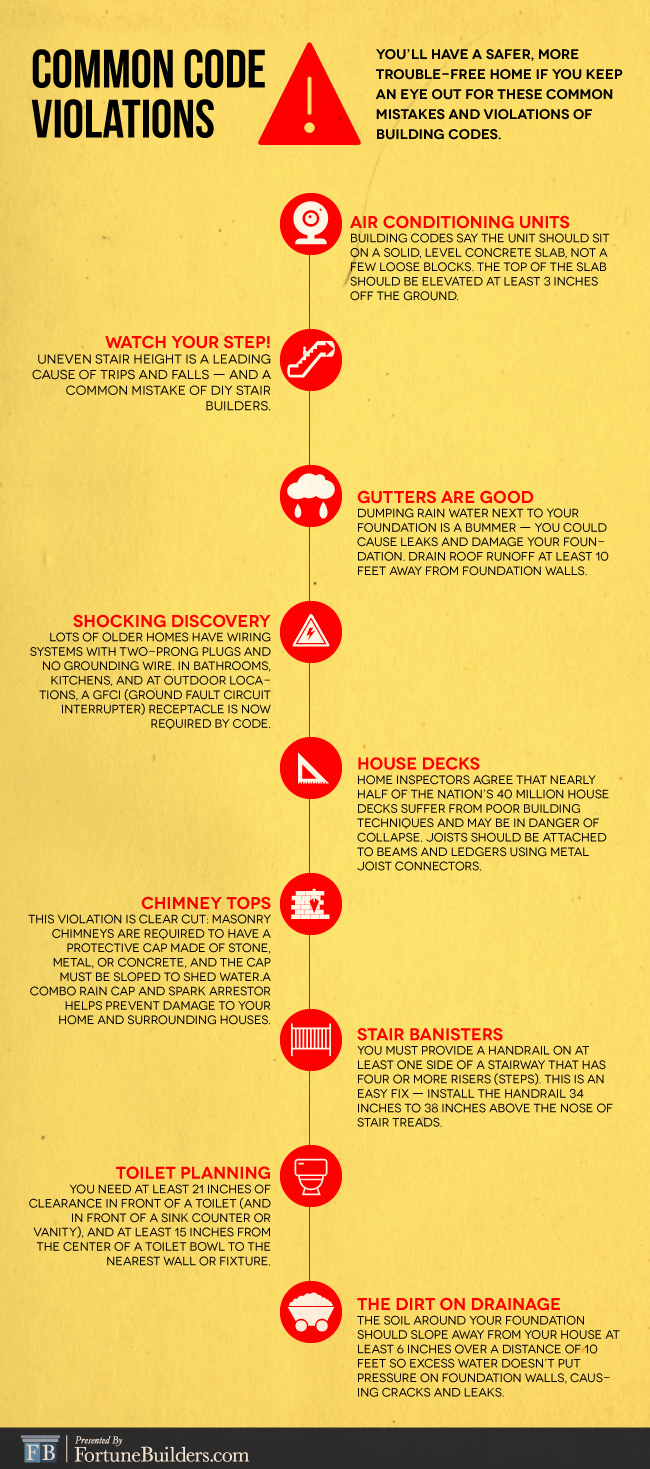Key Takeaways
- A code violations list is a great tool to have on hand whenever you fix and flip a property.
- Some of the most common code violations can occur during DIY projects; make sure you know when to bring in the professionals.
- A few places to look out for code violations are stairways, air conditioning units, and drainage.
Flipping a house is a complicated, yet satisfying experience. On one hand, your hard work and sweat equity will better the lives of those who purchase the property. On the other hand, you are tasked with making sure the home is safe and habitable. That’s why a code violations list is a crucial resource to have on hand.
As you are probably aware, there are specific regulations to follow when renovating a house. Although, not all rules are as upfront and recognizable as you may hope. It is your duty as a fix and flip investor to make sure any changes are up to code and safe for future homeowners. With that in mind, read through the following code violations and make sure you go into your next project prepared.
[ Thinking about investing in real estate? Register to attend a FREE online real estate class and learn how to get started investing in real estate. ]

Common Code Violation List
There are a number of housing laws and codes in place to protect homeowners, and it is crucial that anyone renovating a property become familiar with them. That way you can help ensure you only complete legitimate, high quality deals. Here are the most common code violations to look out for:
-
Heating and air conditioning units must be sized and placed correctly
-
Stairs should be the same height to avoid safety hazards
-
Gutters should drain away from the foundation of the house
-
The electrical systems and outlets need to be inspected, especially in older homes
-
Decks are required to have proper jolts and beams to ensure stability
-
Chimney caps must be shaped to drain water and prevent damage to other homes
-
All stairways need handrails and properly spaced bannisters
-
Plumbing fixtures are required to be placed correctly within bathrooms
-
The ground around the foundation should allow for proper drainage
HVAC Systems
Heating, ventilation, and air conditioning (HVAC) systems are heavily regulated to ensure the safety of a property and to prevent structural damage. Mechanical ventilation systems, for example, must circulate fresh air into buildings. This helps provide fresh air to anyone inside, and keeps moist air from collecting in the home. Additionally, there are environmental HVAC regulations in place to reduce energy waste from these systems. Some state and local areas will actually require that licensed professionals take on these projects. It is crucial to make sure that not only your HVAC systems, but also the installation are up to code.
Staircases
There are height requirements for the ceilings above staircases that should be noted. Most states have regulations stating a minimum ceiling height of 6 feet 8 inches to prevent head injuries. Straight stairways must be at least 36 inches wide, with additional handrail requirements as well. In many areas, spiral staircases will have slightly different size requirements. Be sure to consult your local regulations before starting anything. As a whole, stairs can create a bigger renovation project for flippers and homeowners attempting to bring a property up to code. Keep this in mind as you plan your budget for the overall project.
Gutters
Gutters are required to drain water away from all parts of a property in order to prevent structural damage to a property. First, they keep water from damaging the roof of a property–which can be both dangerous and costly. Gutters also keep basements and lower levels from flooding by ensuring water is properly dispelled away from the house. Further, gutters keep water away from the foundation of the property. This protects against rot, and tree roots which may grow towards water sources causing damage. In most cases, gutters are required to drain water at least ten feet away from the base of the house. Depending on the area, there may also be requirements on the size of gutters.
Electrical
The severity of electrical issues leaves little room for error when it comes to renovating a house. In fact, there are a number of regulations in place to ensure homes are wired correctly. Wires must be properly placed in junction boxes, outlets must be approved, and circuits must be sized correctly. A ground fault circuit interrupter (GFCI) is also required in any areas that have water, such as a kitchen, bathroom or garage. Those working with older homes may find even more electrical issues that must be fixed. To make sure you avoid these common code violations, and to ensure your safety throughout the project, hire a professional before taking a look at any electrical issues.
Decks
Decks can be a great addition to almost any property: they boost not only aesthetics but also the amount of usable space outside. That being said, more often than not decks suffer from poor building techniques. All decks must be built with proper flashing, which acts as a barrier preventing water from entering certain points of the house. The area between a deck and house is a common area for rotting wood, which will harm both the deck and the property. A great way to guarantee any deck is up to code is to work with an experienced contractor.
[Before you start your next rehab project, be sure to check out this guide on finding the right contractor.]
Chimney Tops
All masonry fireplaces are required to have a chimney top to protect the home, and surrounding properties. A masonry fireplace is simply stone, brick or mortar fireplace that is typically constructed at the same time as the rest of the property. Chimney tops help water and snow drain without compromising the structure of the chimney. There are also clearance requirements stating how far a chimney must come up from the roof, which helps reduce the risk for fire or improper ventilation. The main reason chimneys come up as a common code violation is because issues are hard to detect unless a professional inspection is completed.
Banisters
In most areas, stairways with more than two steps are required to have handrails between 30 and 37 inches tall. Decks more than 30 inches are also required to have handrails. These requirements should be followed carefully, as they are put in place to prevent safety issues. Bannisters also come with specific spacing requirements to protect homeowners. The balusters, or vertical shafts supporting railways, should be placed four inches apart maximum. This is to protect small children from potentially falling between railings. If you are working on a property that does not meet these requirements, they can be easy fixes.
Plumbing
Perhaps the most surprising offender on this list of common code violations is putting incorrect spacing around toilets. Toilets must be at least 15 inches away from finished walls, which believe it or not is commonly ignored by builders and contractors. Other plumbing violations to look out for include improper bathroom ventilation, uneven drain slopes, and faulty water heater systems. Each of these violations can cause both property damage and safety concerns for homeowners. Similarly to electrical issues, it is typically best to work with a professional on any plumbing fixes.
Drainage
Drainage not only refers to plumbing systems, but also the foundation of a property. According to many state and local regulations, the soil surrounding a house must slope away from the property for at least six inches across ten feet. This is meant to prevent water from pooling and causing foundational cracks around the property. Many properties are built with this in mind, however as homes age the ground can eventually settle. This will cause a dip, that may not even be visible at first glance. It is crucial to look out for potential drainage issues when touring potential fix and flip properties.

Summary
Fix and flip investing has proven time and time again to be a lucrative investment strategy. Unfortunately, that doesn’t mean it will work for everyone. In order to be successful flipping houses, investors will need a strong attention to detail and a comprehensive understanding of what problems to look out for. Keep a code violations list on hand anytime you begin a fix and flip deal, and you can help ensure the integrity of any property you renovate.
Have you used our list of building code violations on a renovation project? Share how it helped you in the comments below.
